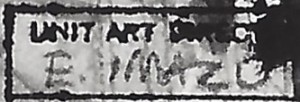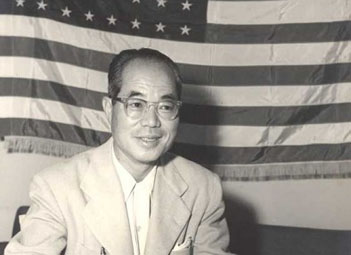Eddie Imazu was an art director at MGM Studios during the golden era of cinema, spanning the anti-immigrant and WWII eras when few Japanese Americans attained professional status. This website is an archive of his work and a resource for historians.
As a draftsman, associate and art director, Imazu designed movie sets at MGM for 35 years and was co-nominated for an Academy Award in 1936. A Japanese emigre and former architecture student, Imazu worked with Frank Sinatra, James Stewart, John Wayne, Yul Brynner, Robert Wagner and Marlon Brando.
Imazu joined Metro studios as a draftsman in 1920. He remained at the studio until its merger with Goldwyn Pictures to form Metro-Goldwyn-Mayer in 1924. In 1929, MGM promoted him from draftsman to art director.
During the early 1930s, Imazu met Aiko Kondo, a cousin of Mary Yuriko Kochiyama (nee Nakahara), who became a prominent civil rights activist. Because she was beautiful, Aiko attracted many suitors, mostly naval officers whose ship had docked in San Pedro harbor. Aiko’s father didn’t trust these young sailors, so he asked a pre-teen Mary Nakahara to accompany Aiko on her dates.
 Mary, later known as “Yuri,” recalled feeling awkward about her third-wheel presence but relieved that Aiko never showed the slightest irritation. Yuri also recalled that Aiko Kondo was a portrait artist from an artistic family. When Yuri and her two brothers visited the Kondos, the siblings ran straight to the wastebaskets. They would rifle through the contents to retrieve discarded art, which they would take home.
Mary, later known as “Yuri,” recalled feeling awkward about her third-wheel presence but relieved that Aiko never showed the slightest irritation. Yuri also recalled that Aiko Kondo was a portrait artist from an artistic family. When Yuri and her two brothers visited the Kondos, the siblings ran straight to the wastebaskets. They would rifle through the contents to retrieve discarded art, which they would take home.
During the mid-1930s, Eddie Imazu married Aiko Kondo, creating a very happy, artistic union. In a 1947 interview with Pacific Citizen, Aiko Imazu said she preferred to make “rough sketches executed mostly in charcoal,” whereas her husband created more complicated and detailed renderings. Aiko’s brother Takashi “Teek” Kondo, an accomplished cartoonist, eventually became an MGM employee in the art department. Eddie and Aiko Imazu raised two daughters, Joyce and Darleen.
On December 7, 1941, Japan attacked Pearl Harbor, and President Franklin Roosevelt issued Executive Order 9066, purportedly for security reasons. The Order required all Japanese Americans and Japanese immigrants to evacuate from the west coast and relocate at isolated, inland detention centers surrounded by barbed wire and guard towers. To retain Imazu as an art director, MGM offered him living accommodations inside the studio. But the government required Aiko Imazu and daughters to report to the Santa Anita Assembly Center and later to the Jerome and Rohwer relocation camps. So Imazu chose to accompany his family into relocation.
After release from detention, Imazu returned home to Culver City in the Los Angeles area. The next day, Cedric Gibbons, supervising art director at MGM, wired Imazu to offer him his old job. Studio head, Louis B. Mayer, usually inaccessible to Hollywood VIPs, personally greeted Imazu back to work. Well-liked and respected by colleagues, Imazu worked at MGM Studios for 35 years.
During the 1950s, Imazu became a naturalized American citizen. An inside-page interview of Imazu, at age 50, appeared in the December 20, 1947 edition of Pacific Citizen, a Japanese-American newspaper. The headline reads, Hollywood Story: A Portrait of Eddie Imazu, Art Director at MGM Studios. And the byline reads, By Alice Sumida. In the 24-inch profile, Imazu describes how he works.
First, he reads the script. If the movie must be shot on location, Imazu travels to an appropriate area and selects a site. For a studio movie, Imazu spends one or two months breaking the story into sets, estimating costs, making layouts, sketching and drawing models, and consulting the director. Imazu lines up the sets needed to ensure they’re built in the proper order. He does a “roughing out,” followed by a drafting.
After the models are drawn, the director studies them and may suggest changes. If the proposed budget is suitable and the director is satisfied, the set plans go from the draftsman’s workroom to the mill, where the units are made. After they’re built, the sets are assembled on the stage and set up. Lastly, each set is painted, dressed and made ready to shoot. In technicolor movies, the set’s colors must beautifully offset the costumes, so wardrobe designers contribute ideas. Imazu’s budget is 12% to 15% of total production cost, usually about $250,000. A studio movie costs at the very least $1.5 million.
In 1936, Eddie Imazu was an Academy Award co-nominee for Best Art Direction on The Great Ziegfeld. Imazu’s film credits include: McLintock! (1963); The Man Who Shot Liberty Valance (1962); The Teahouse of the August Moon (1956); Go For Broke! (1951); and Three Wise Fools (1946). His television credits include: “The Twilight Zone” (1964); Combat! (1963-1964); and The Thin Man (1958).
After retiring from MGM in the late 1960s, Imazu fell into poor health. He died May 29, 1979 at age 81 in Los Angeles, California. Aiko Kondo Imazu died in April 1983.


